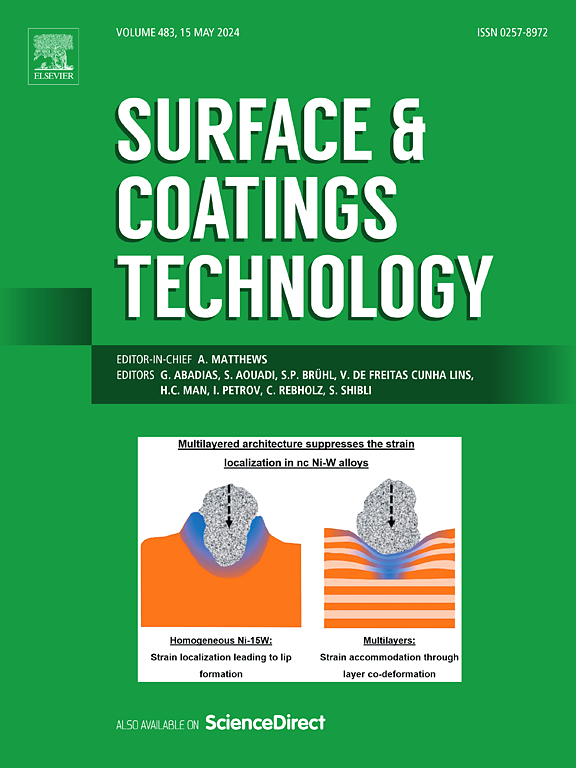Microstructure evolution of martensite and carbides in 8Cr4Mo4V steel after nitrogen ion implantation
IF 5.3
2区 材料科学
Q1 MATERIALS SCIENCE, COATINGS & FILMS
引用次数: 0
Abstract
In our previous study, nitrogen plasma immersion ion implantation (N-PIII) was employed to modify the surface of the 8Cr4Mo4V steel, achieving significant improvements in surface hardness and wear resistance. To elucidate the mechanisms behind these improvements, the element concentration, phase composition, and microstructure of the implanted layer were analyzed in this study. The results show that a part of the nitrogen atoms dissolved into the martensite lattice, and the metal atoms at the boundaries of the martensite laths will capture the N atoms, causing them to move to a deeper position. While another part of the nitrogen atoms combined with hexa-M₂C (M is mainly Mo) and fcc-MC (M is mainly V) carbides in 8Cr steel to form fcc-M2CxN1-x/MCxN1-x (M is mainly Mo) and fcc-MCxN1-x (M is mainly V) carbonitrides. Furthermore, the dislocation multiplication during the N-PIII process will occur at a depth deeper than the implanted layer. These solid solution strengthening, hard secondary phases, and dislocation defect strengthening all contributed to the increase of mechanical properties in the surface layer of the 8Cr steel. In this study, the microstructure evolution of 8Cr4Mo4V steel after N-PIII was analyzed in detail, which is an effective supplement to the understanding of the microstructural evolution of steels subjected to ion implantation.

氮离子注入8Cr4Mo4V钢后马氏体和碳化物的组织演变
在我们之前的研究中,采用氮等离子体浸泡离子注入(N-PIII)对8Cr4Mo4V钢的表面进行了改性,表面硬度和耐磨性得到了显著提高。为了阐明这些改进背后的机制,本研究分析了植入层的元素浓度、相组成和微观结构。结果表明,部分氮原子溶入马氏体晶格,马氏体板条边界处的金属原子会捕获N原子,使其向更深的位置移动。而另一部分氮原子与六碳-M₂C (M主要是Mo)和fcc-MC (M主要是V)碳化物在8Cr钢中结合形成fcc-M2CxN1-x/MCxN1-x (M主要是Mo)和fcc-MCxN1-x (M主要是V)碳氮化物。此外,在N-PIII过程中,位错倍增将发生在比植入层更深的深度。固溶强化、硬次生相强化和位错缺陷强化均对8Cr钢表层力学性能的提高有促进作用。本研究详细分析了8Cr4Mo4V钢经N-PIII处理后的组织演变,是对离子注入钢组织演变认识的有效补充。
本文章由计算机程序翻译,如有差异,请以英文原文为准。
求助全文
约1分钟内获得全文
求助全文
来源期刊

Surface & Coatings Technology
工程技术-材料科学:膜
CiteScore
10.00
自引率
11.10%
发文量
921
审稿时长
19 days
期刊介绍:
Surface and Coatings Technology is an international archival journal publishing scientific papers on significant developments in surface and interface engineering to modify and improve the surface properties of materials for protection in demanding contact conditions or aggressive environments, or for enhanced functional performance. Contributions range from original scientific articles concerned with fundamental and applied aspects of research or direct applications of metallic, inorganic, organic and composite coatings, to invited reviews of current technology in specific areas. Papers submitted to this journal are expected to be in line with the following aspects in processes, and properties/performance:
A. Processes: Physical and chemical vapour deposition techniques, thermal and plasma spraying, surface modification by directed energy techniques such as ion, electron and laser beams, thermo-chemical treatment, wet chemical and electrochemical processes such as plating, sol-gel coating, anodization, plasma electrolytic oxidation, etc., but excluding painting.
B. Properties/performance: friction performance, wear resistance (e.g., abrasion, erosion, fretting, etc), corrosion and oxidation resistance, thermal protection, diffusion resistance, hydrophilicity/hydrophobicity, and properties relevant to smart materials behaviour and enhanced multifunctional performance for environmental, energy and medical applications, but excluding device aspects.
 求助内容:
求助内容: 应助结果提醒方式:
应助结果提醒方式:


